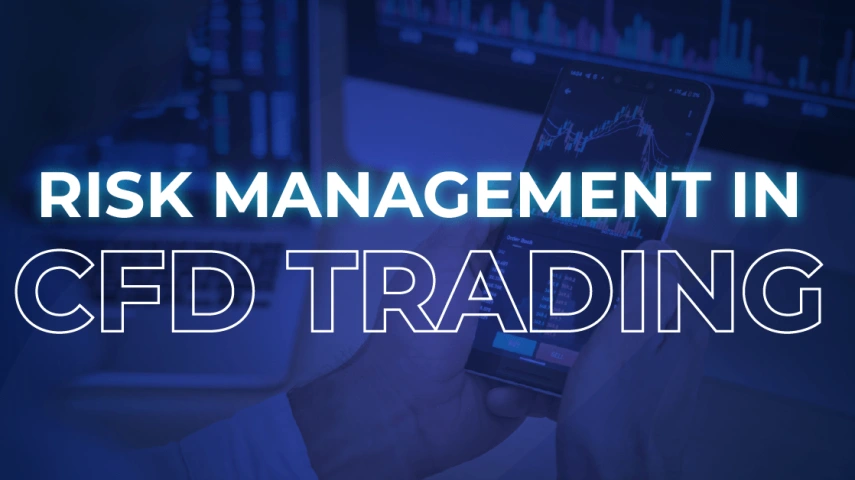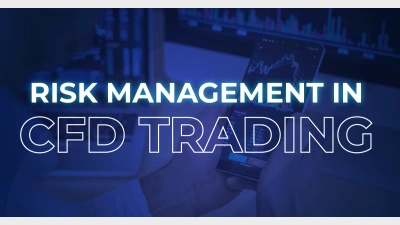How to Manage Risk in CFD Trading



Risk is always a part of CFD trading, but this doesn't mean you just need to give in to the dangers. A responsible approach to risk management can offer some protection.
CFDs can be a great way to achieve flexibility when trading, and potentially profit from even the smallest market movements. However, this type of trading is not without risk.
This is why risk management is important in CFD trading. The right approach can minimise the loss potential, while increasing the chance for profit.
What is CFD Trading?
The acronym ‘CFD’ just means ‘contract for difference’. This is a method of speculating on financial markets without actually buying and holding any of the assets.
To trade CFDs, you first choose your asset. This is the market instrument that gives the CFD its value. You then predict whether the value will move up or down, and you open your position to reflect this.
If you were right, you’ll receive a profit. If you were wrong, you lose money from your trading account.
CompareForexBrokers founder Justin Grossbard explains the relationship between risk and reward in CFD trading:
“CFD trading is based on risk. The very reason there is a potential reward is because of the danger of losing money,” Justin said.
“The trick is to manage this risk. Over time, you’ll learn how to pursue CFD trading profits responsibly and sustainably, while keeping the danger to a minimum.
Five Ways to Manage Risk When Trading CFDs
So how do you trade CFDs responsibly and sustainably? Here are five ways to achieve this.
Only Trade with Regulated Brokers
You should never trade with an unregulated broker. These brokers are not overseen by independent regulators and do not hold licenses, so trading with them is simply too risky.
Look for brokers with licenses from tier-1 regulatory bodies. In Australia, it’s the Australian Securities and Investments Commission (ASIC) that regulates CFD trading. Choose one of the top ASIC-regulated CFD brokers and ensure you’re protected in Australia.
Use the Risk Management Features Brokers Provide
Brokers provide risk management tools and features to protect you. So make sure you use them. Some of these features will be applied automatically. Negative balance protection, for example, is something all ASIC-regulated brokers need to offer.
Others, you’ll need to apply yourself. A stop-loss feature will close your position if your losses exceed a defined level. A take-profit feature is essentially the opposite – it closes your position if your profits go beyond a level you’ve set. Both of these features help to keep your trades sustainable.
Try Out New Strategies with a Demo Account
Most brokers and platforms offer a trading demo account, where you can practice trading with virtual funds and without risk. A common misconception is that demo accounts are exclusively for beginner traders. This actually isn’t true.
While beginners should definitely get used to trading on a demo account, other traders can benefit too. Whenever you try out a new strategy, trade a new instrument, or even just make a little tweak to your approach, give it a try in the demo account first.
Increase Leverage Slowly
Leverage is a fact of life when trading CFDs, and you’ll always be using at least some leverage. Increasing this can bring significant rewards, but just remember that high leverage also equals high risk.
When trading with an ASIC-regulated broker, you’ll only be able to increase leverage up to a maximum of 30:1 but even this can result in heavy losses if a trade goes wrong. This is why it’s important to build leverage slowly, and to stick to familiar markets whenever you increase the ratio.
Build a Strategy and Stick to It
One of the biggest reasons traders lose money is that they get greedy and make impulse moves. Avoid this by building a robust strategy, and sticking to this strategy. This doesn’t mean you shouldn’t change your strategy if you need to but changes need to come from considered analysis, not just an impulse decision in the moment.
Calculated Risks, Not Random Movements
Success in CFD trading comes from understanding and counteracting risk. Risk never completely goes away, but experienced traders make calculated strategic moves, rather than acting at random.
For Justin Grossbard, this is key:
“Over time, traders get used to recognising levels of risk, and understanding when to trade and when to hang back,” Justin said.
“It’s never an exact science, and traders of all levels can make losses. However, a careful approach to risk management and a willingness to learn will help you. You can begin to tip the balance at least a little bit in your favour.”
Recommended for you
Everyone has their own reason for wanting to stay healthier, for longer.As a super fund, you're in a unique position to ...
The evolution of financial technology continues accelerating with the emergence of high-speed blockchain networks that e...
Australian property prices are rising again, presenting a compelling opportunity for investors. For the first time in fo...
For the first time in four years, every Australian capital city recorded simultaneous quarterly price growth—fuelle...









